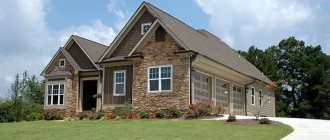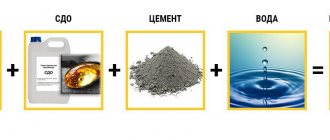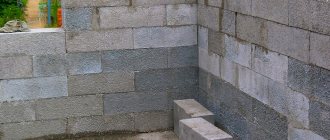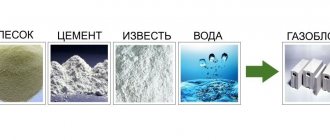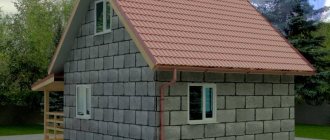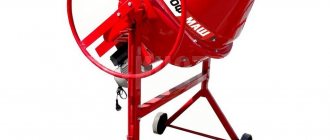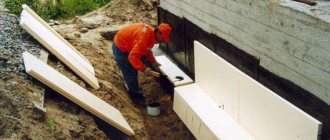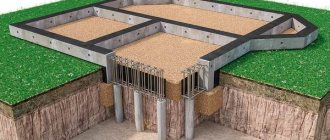This building material does not have a presentable appearance, but the technical characteristics make the sand-cement block very popular for private construction. The main advantages of sand block are its low price, low consumption of cement mortar and ease of laying. All this makes building a house from sand blocks a very attractive and practical process. It is worth noting that the actual construction of the house itself is significantly different from the construction of a brick house. Construction can be carried out from sand blocks of various types: hollow, solid, with recesses . This building material will provide you with budget housing, since the construction of affordable housing has been underway for a long time and is in demand. In general, little information is known about sand blocks; most have not even heard of them. However, comparing it with other block materials, sand block stands out favorably against their background. Its main advantage is increased moisture resistance. This property is very important for a residential building, as it determines resistance to temperature changes. In Russia, this phenomenon has become normal, so building a house from sand blocks is an excellent choice for a small building.
How much does a foam block cost per piece?
But the main advantage is considered to be affordability - the average cost of one foam block for the construction of walls measuring 600x400x200 mm is 120 rubles; with minimal effort, the future owner receives a wall 40 cm thick for 1000 rubles.
Interesting materials:
How to properly store roses in the cellar in winter? How to properly store roses in water? How to properly store rose seedlings in winter? How to bathe roses correctly? How to properly cut rose cuttings for propagation? How to cut rose cuttings correctly? What is the correct name for the Peony Rose? How to properly earth up roses for the winter? How to open roses in spring? How to transplant home roses correctly?
Low cost and decent quality
For the average resident of Russia, the low cost of building their own housing is also important. A house made of sand blocks is a fairly cheap structure, so many people choose this type of construction. A house made of sand concrete blocks is distinguished by its high manufacturability, since this material meets all modern requirements for quality, reliability, shape and strength. These properties are ensured due to the simplicity of the block manufacturing process.
Quality standards correspond to the European level, so building a house from sand blocks is profitable and affordable.
To make the block, high-grade cement is used, which results in the required strength and density of the final product. We will separately indicate the disadvantages of a house made of sand blocks. The main thing is low heat saving rates. Therefore, the constructed house will have to be insulated. Also, sand concrete blocks have a significant mass, which requires the construction of a solid foundation. The cost of eliminating these shortcomings is recouped by the minimal cost of the blocks themselves, which will negate all the disadvantages.
Building a house from sand blocks can have an aesthetic appearance. This is achieved by using colored block designs. It is possible to combine different colors, which will allow you to implement design solutions. All sand blocks are frost-resistant and fireproof, which also speaks in favor of choosing this building material for building your own home. If you doubt the qualities of sand blocks, then they can be used as a material for laying doorways, windows and other wall structures. It is most advisable to use blocks of this type for the construction of partitions. Firstly, it is inexpensive, and secondly, it increases the safety of your home. This will also help reduce the cost of construction, without loss of functional qualities and reliability.
Thus, building a house from sand blocks has the following advantages:
- Ease of building a house, since the use of special tools and devices is not required;
- Block masonry has less weight than brick, while the efficiency achieved is an order of magnitude greater;
- For load-bearing structures, this is an almost ideal building material, since there are no analogues with the same properties yet.
How to save 120 thousand rubles when building a house with an area of 100 square meters?
Block construction is gradually replacing the once traditional wood and brick. The advantages are obvious: large, even blocks are laid easily, the process of building a house is accelerated, and less mortar is needed. As for the reliability of structures, manufacturers and sellers of building materials promise: there will be no problems. In many characteristics, the blocks are superior to “classic competitors”.
Perhaps the main difficulty that the future owner of a house, garage or bathhouse faces is choosing from many options. There are a variety of blocks on the market: aerated concrete, foam concrete, polystyrene concrete, sand blocks can be used as materials for walls. What's better? Manufacturers are waging real advertising wars, positioning their products as the best option.
It so happens that huge advertising budgets are poured into the promotion of so-called cellular and lightweight concrete - aerated concrete, polystyrene concrete and foam concrete. These materials are relatively new to the Russian market and therefore require popularization. And advertising has an effect: aerated concrete and polystyrene concrete are already quite widely used in construction. But the most popular does not mean the only correct one.
Types and parameters of blocks
Depending on the presence of cavities, materials are differentiated by type:
- Hollow type, providing thermal insulation of buildings and protection from extraneous sounds. They are in demand when constructing permanent walls and are easily combined with other finishing materials. The weight of the products ranges from 8 to 40 kg.
- Solid construction for increased durability. It is used in the construction of foundations; its characteristics correspond to the parameters of silicate products. Weight – from 100 to 2000 kg.
Characteristics and technologies according to the standard
Let's take a closer look at the properties of the material. So, a sand block (also known as a sand-cement block, concrete wall stone) is a vibro-pressed block of semi-dry concrete, which has very high strength, good vapor permeability (it “breathes” much like wood), a long service life and, which is important in the current time of crisis - -increased efficiency in construction.
The composition includes only safe, environmentally friendly materials - sand, water and cement. The raw materials are also inexpensive, which makes the cost of sand blocks affordable for the mass buyer.
Anton Mazurov, chief technologist at the Concrete Factory: “According to our calculations, sand blocks are by far the most inexpensive material*. It is suitable for almost any building - houses, cottages, offices, shops, garages, baths. Moreover, when using sand block with insulation, the wall is as warm, durable, moisture-resistant and cheap as possible. A square meter of a wall made of sand blocks with 100 mm insulation is 1.5–2 times cheaper and 30% warmer * than a similar wall made of aerated concrete or polystyrene concrete.
At the same time, sand blocks have high strength and are not afraid of moisture. We specifically seriously analyzed SNiPs, GOSTs and other regulatory construction documents. I can say with complete confidence: the characteristics of sand blocks allow them to be widely used in construction and, with significant savings in money and time, guarantee the durability of buildings and comfortable living.
Among the advantages of sand block, we highlight several key ones:
- The strength of M150 sand block is more than twice as high* as that of aerated concrete or polystyrene concrete;
- Even when using insulation, a house made of sand blocks will cost less than a similar structure made of aerated concrete or polystyrene concrete;
- One square meter of a sand block wall with insulation will cost about a thousand rubles, and materials for the walls of a house with an area of one hundred square meters will cost only 98,000 rubles;
- The microclimate in houses made of sand blocks can be compared to the atmosphere of a wooden house. The block is made by semi-dry vibrocompression, so the structure of the material differs from that produced by liquid concrete used in the construction of high-rise buildings. That is why sand block is a “breathable” material;
- Another significant advantage of a sand block wall is excellent sound insulation;
- Irkutsk belongs to a zone of increased seismicity with a high probability of earthquakes up to magnitude 9. When building a 2-3-storey building from aerated concrete and polystyrene concrete in a 9-point seismic zone, it is necessary to build a frame, usually from reinforced concrete. These are vertical reinforced concrete cores (columns) in the corners and inside the walls every 4 meters, as well as a seismic belt. The process is labor-intensive, slow and expensive. However, if you are building a house from sand blocks, then you can do without vertical cores. And the set of rules for construction in seismic areas (SNiP II-7-81) contains the following standards for number of storeys:
- Sand blocks are heavier than aerated concrete and polystyrene concrete, and many fear that the foundation will need to be strengthened. In fact, when building with sand blocks, the additional load on the foundation is negligible. Compared to aerated concrete, the load increases by only 0.1%. Typically, the safety margin of the foundation is at least 15%, or even more. So there will be no additional costs for the foundation.
One sand block of increased size 40x30x20 cm replaces 14 bricks. This significantly reduces mortar consumption and shortens construction time.
Andrey Matveev, director of the design and architecture studio KSI: - For those planning construction, I recommend taking a closer look at sand blocks. The technology for building houses from this material will, of course, require insulation. But even in this case, the figure in the final calculations will be significantly lower than, for example, when using alternative options - aerated concrete or polystyrene concrete.
How are cement-sand blocks produced?
Basic components for making sand blocks:
This composition of ingredients allows material manufacturers to not only save financial resources due to the low cost of raw materials, but also provide improved performance characteristics. The popularity of sand blocks has increased among customers, as it is a competitive raw material used in the construction of structures.
Manufacturing involves the technology of semi-dry vibrocompression on equipment with increased productivity. The production stages are as follows:
- Mixing raw materials components.
- Filling into steel molds.
- Compacting the fraction until homogeneous.
- Drying products under infrared rays.
- Keep in a ventilated room at room temperature for 4 weeks.
The main parameter is strength - the blocks are acquired after the final stage. Thanks to this, the service life of buildings constructed from them is more than half a century. This reduces the cost of repairing the facility over a long period after construction. The technology allows the use of a special filler during production, which reduces the impact of the weight of the object under construction on the foundation.
German quality block from Irkutsk manufacturer
In Irkutsk, the only modern high-tech automated line for the production of sand blocks is installed at the Concrete Factory production facility. German equipment for the plant was purchased two years ago. Today, the dosing of components is carried out by computer through strain gauges. The blocks undergo heat treatment in a steaming chamber. The pressure when compressing the block is more than 150 kN, which is approximately comparable to the pressure of a house on the foundation. Capacity is 12,000 blocks per shift, and the line employs only two people - a line operator and a forklift operator.
Andrey Rudykh, director of production at the Concrete Factory: “The Germans, as you know, are scrupulous people and love precision. Their equipment too. After we have automated production, there is no doubt that the quality and geometry of the block meets the highest requirements.
“Factory Concrete” guarantees the buyer compliance with standards, which means the reliability and durability of buildings using our materials. At the same time, we strive to make the construction process convenient and fast, because the construction season in our climate is quite short. And not so long ago, in addition to the standard one (40x20x20 centimeters), a new block with dimensions of 40x30x20 centimeters appeared in the plant’s assortment. It replaces 14 bricks and is used to build thicker walls; a wall thickness of 30 centimeters is the optimal solution for the Siberian region. But the main thing is that with a thickness of sand blocks of 30 centimeters, SNiPs allow the construction of walls 2.7-3.6 meters high from them.
Sand block buildings in our latitudes actually last for decades. You don't need to look far for examples. For example, a multi-storey building on Polenova Street. And not so long ago, beautiful modern microdistricts were built from blocks produced at the Concrete Factory in Cheremkhovo and Svirsk. Over three years, about 75 thousand square meters of housing were commissioned in these cities. More than 250 families moved from emergency barracks to comfortable three-story houses.
The implementation of this country's priority program for resettlement from dilapidated and dilapidated housing is personally monitored by President Vladimir Putin. All projects and materials undergo state examination at the federal level. The sand blocks of the Irkutsk manufacturer passed the test with dignity. They meet all requirements for strength and comfort, and at the same time optimize budget expenditures through a reasonable approach to the selection of materials and construction technologies without loss of quality.
“Quality is an absolute priority for Betonov Factory,” says Ilya Balk, General Director of Betonov Factory LLC. - In our business it is impossible otherwise. People build houses and expect that they will raise their children and grandchildren in them and pass them on to future generations. We have no right to let you down.
The desire to build their own country house is common among people. Which material should you prefer? One of the popular materials is sand block. Can sand block walls provide strength, environmental friendliness and comfortable thermal conditions in a future building?
Today, customer interest in block raw materials offered on the construction market has sharply increased. Without being a builder or designer, it is difficult to make the right decision without making a mistake. Sand-cement blocks are widely used in individual construction and the construction of industrial facilities. We advise you to familiarize yourself with the operational characteristics, study the advantages and disadvantages, tested in practice. We will help you decide!
